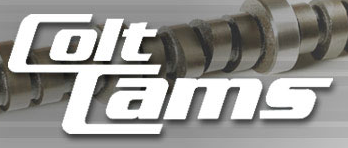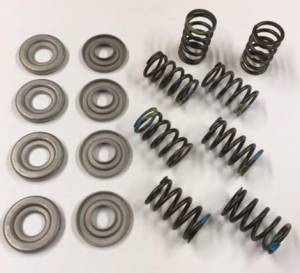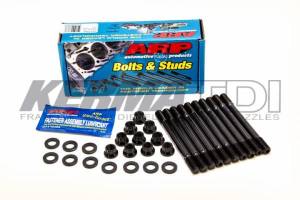
Here are the steps to check install the Colt Stage 3 cam. Having two people helped a lot to make the process more efficient and quickened the job altogether.
First, remove the original cam shaft and hydraulic lifter cups. Once these are out, use Brake Kleen and a shop vac nozzle, to clean out excess oil so aluminum shavings left behind by the grinding later on don't stick to the head. Next, while the lifter cups are out, rotate the new cam shaft in to the head to check clearance, but do not install bearing caps yet.
Make marks on the head to indicate where you'll need to grind for clearance. Making the marks with a marker not only shows where to grind, but will help you know when to stop grinding (when the black marks are gone, you should be able to stop).
At this point use a dye grinder with an aluminum carbide bit to grind. I prefer the 6 inch long bit. Keep using the shop vac (holding it as close to the grinder as you can) to catch aluminum shavings as you grind (this is where having two people to do the job is helpful).
When satisfied with clearance, spray more Brake Kleen while continuing to hold the vacuum nozzle close to cause a flushing action to dispose of any left over shavings (a simultaneous spray/vacuum process sweeps away shavings most effectively--experimenting with this process during the initial cleaning process will give you a better feel for it when cleaning out the shavings later on when it's most crucial). Inside hydraulic lifter cups is the critical area where shavings should not be left behind. After the head has been thoroughly cleaned, install new cam and lifter cups.
BREAK IN PROCEDURE
- Cam Lube on all lobes, lifter faces, distributor gears and oil pump gears.
- Oil all bearing journals and lifter barrels.
- Always turn engine over by hand before starting, check for clearances and proper timing location.
- Fire up to 1800 - 2000 r.p.m. for 18 - 20 minutes.
Note: Most oil companies have taken out a percentage of additives that are meant for anti-scuffing for break in on flat tappet cams, so please ask your local auto parts professional for the best zinc additive they have and add it to your oil before you fire-up your engine for the first time.
There are many so called Performance Camshafts available in the market today at half the price of a Chilled Cast Performance Camshaft.
Most camshafts are not designed to handle the stress that is applied in a VW TDI and therefore can cause premature failureto the cam lobe areas. What is CHILLED CAST?
What is CHILLED CAST?
When the camshaft is cast in the foundry, the iron is poured and hardens off very quickly (known as Chilling) this causes the material to form a matrix of carbide on the cam lobe.
Chilled Cast material is exceedingly scuff-resistant and is the industry standard material for producing Quality OHC PerformanceCams.
Note: VW PD engines [like BEW, BHW, BRM , PD130, PD150] require a special cam made a fully machined from bar stock steel billet which kermaTDI also carries We are the exclusive supplier of these ultimate forged billet PD cams.





